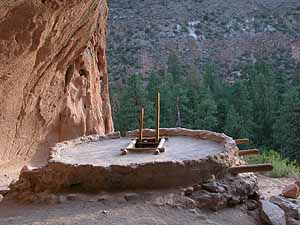Tsankawi | Tsankawi Cave Dwellings | Tsankawi Petroglyphs

| Chronology of Events |
|---|
|
1.6 Million & 1.2 Million Years Ago
Tremendous series of volcanic eruptions (600 times larger than Mount St. Helens) from the Jemez Mountains create the Pajarito Plateau. |
|
8000 BC According to archeological evidence, humans first occupy the Nothern Rio Grande Valley around this time. |
|
600 AD Beginning of Develomental Period in Pueblo Cultural Sequence in Rio Grande Valley. Temporary sites appear around Sante Fe area. |
|
Mid 1100s Ancestral Pueblo people settle on the Pajarito Plateau and in Frjoles Canyon. They lived in the canyon until the mid 1500s. |
|
1740 Captain Andres Montoya Petitions the Spanish Crown for the land grant between Ancho and Alamo Conyons, which includes Frijoles Canyon. His Descendents remain until 1811 when the Spanish authorities order the area cleared because it had purportedly become a "den of outlaws". |
|
1880 People from Cochiti Pueblo guide historian and ethnologist Adolph Bandelier to their ancestral homes Frijoles Canyon. Describes the canyon in his journal as the "grandest thing I ever saw." |
Bandelier National Monument
The drums beat no more, and the songs are now silent. Yet the spirit
of those who lived here continues to dwell in the magic that is Bandelier
National Monument. Natural beauty and years of culture bring to life the
enchanted land of tan cliffs, forested mesas, and deep gorges.
-- Cecilia Shields
It was not until October 1880 when Adolph Bandelier, for whom the Monument is named, and his Cochiti Indian guide Juan José Montoya ventured into Frijoles Canyon that the magic of Bandelier was revealed to the world beyond the area Pueblos and early Spanish settlers (who moved into the area in the 1740s). Proclaiming it "the grandest thing I ever saw," Bandelier paved the way for others to explore the Pajarito Plateau and document the area's rich cultural history. Indeed, individuals such as Edgar Lee Hewett played a defining role in the development of modern archeologocal techniques with their work at Bandelier in the early 20th Century.